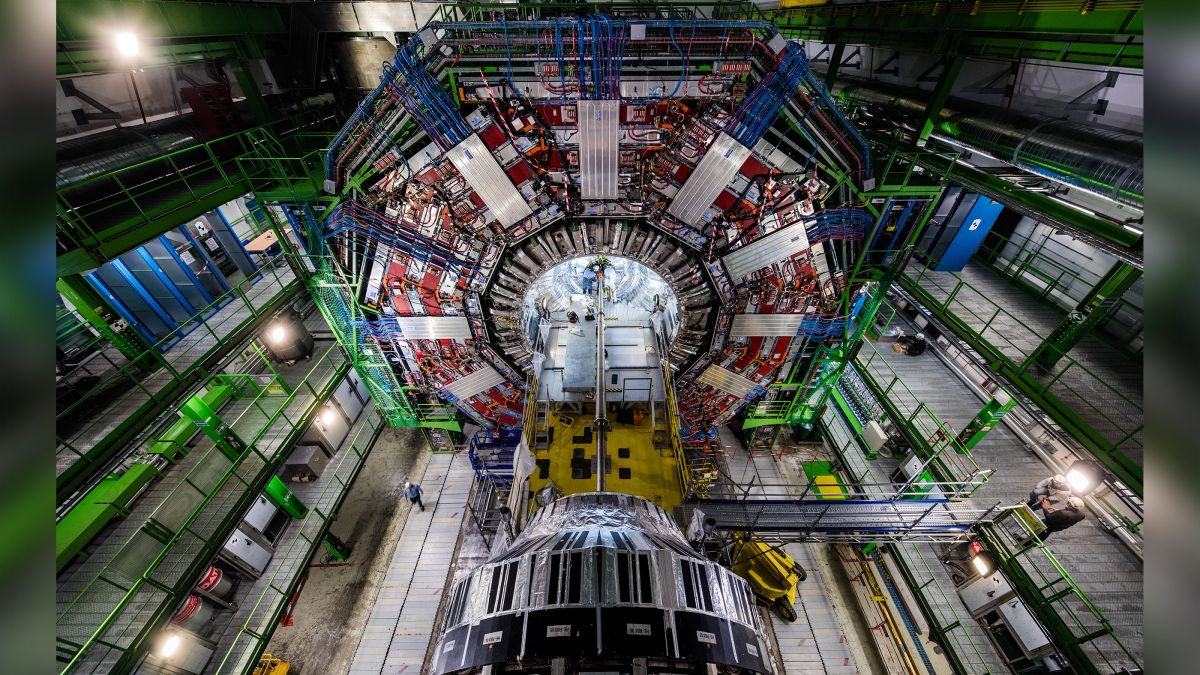The Large Hadron Collider has been turned back on today (July 5) and is set to smash particles together at never-before-seen energy levels.
The Large Hadron Collider (LHC) is the world’s largest and most powerful particle accelerator. Located at CERN near Geneva, Switzerland, the nearly 17-mile-long (27 kilometer) loop was fired up today after spending four years offline for upgrades. With these fixes completed, scientists want to use the gigantic accelerator to smash protons together at record-breaking energies of up to 13.6 trillion electron volts (TeV) — an energy level that should up the odds of the accelerator producing particles not yet observed by science.
The upgrades to the accelerator’s particle beams have done more than spike their energy range; an increased level of compactness, making the beams denser with particles, will increase the probability of a collision so much that the accelerator is expected to capture more particle interactions in its third run than it did in its previous two combined. During the two previous stints, running from 2009 to 2013 and 2015 to 2018, the atom smasher shored up physicists’ understanding of how the basic building blocks of matter interact — called the Standard Model — and led to the discovery of the long-predicted Higgs boson, the elusive particle which gives all matter its mass.
Related: ‘X particle’ from the dawn of time detected inside the Large Hadron Collider
But, in spite of the accelerator’s experiments, which produced 3,000 scientific papers on many minor discoveries and tantalizing hints of deeper physics, scientists have yet to find conclusive evidence of new particles or brand-new physics. After this upgrade, they’re hoping that will change.
“We will measure the strengths of the Higgs boson interactions with matter and force particles to unprecedented precision, and we will further our searches for Higgs boson decays to dark matter particles as well as searches for additional Higgs bosons,” Andreas Hoecker, a spokesperson of the LHCs ATLAS collaboration, an international project that includes physicists, engineers, technicians, students and support staff, said in a statement (opens in new tab).
Inside the LHC’s 17-mile-long underground ring, protons zip around at near light-speed before slamming into each other. The result? New and sometimes exotic particles are formed. The faster those protons go, the more energy they have. And the more energy they have, the more massive the particles they can produce by smashing together. Atom smashers like the LHC detect possible new particles by looking for telltale decay products, as the heavier particles are generally short-lived and immediately break down into lighter particles.
One of the LHC’s goals is to further scrutinize the Standard Model, the mathematical framework physicists use to describe all of the known fundamental particles in the universe and the forces through which they interact. Though the model has been around in its final form since the mid-1970s, physicists are far from satisfied with it and are constantly looking for new ways to test it and, if they’re lucky, discover new physics that will make it fail.
This is because the model, despite being the most comprehensive and accurate one so far, has enormous gaps, making it totally incapable of explaining where the force of gravity comes from, what dark matter is made up of, or why there is so much more matter than antimatter in the universe.
While physicists want to use the upgraded accelerator to probe the rules of the Standard Model and learn more about the Higgs boson, upgrades to the LHC’s four main detectors also leave it well positioned to search for physics beyond what is already known. The LHCs main detectors — ATLAS and CMS — have been upgraded to collect more than double the data they did before in their new task of looking for particles that can persist across two collisions; and the LHCb detector, which now collects 10 times more data than it used to, will search for breaks in the fundamental symmetries of the universe and for explanations why the cosmos has more matter than antimatter.
Related: Physicists discover never-before seen particle sitting on a tabletop
Meanwhile, the ALICE detector will be put to work studying collisions of high-energy ions, of which there will be a 50-fold increase in those recorded compared to prior runs. Upon smashing together, the ions — atomic nuclei given electrical charge by the removal of electrons from their orbital shells — produce a primordial subatomic soup called quark-gluon plasma, a state of matter which only existed during the first microsecond after the Big Bang.
In addition to these research efforts, a slew of smaller groups will probe at the roots of other physics mysteries with experiments that will study the insides of protons; probe the behavior of cosmic rays; and search for the long-theorized magnetic monopole, a hypothetical particle that is an isolated magnet with only one magnetic pole. Added to these are two new experiments, called FASER (Forward Search Experiment) and SND (Scattering and Neutrino Detector), that were made possible by the installation of two new detectors during the accelerator’s recent shutdown. FASER will scan for extremely light and weakly interacting particles, such as neutrinos and dark matter, and SND will exclusively search for neutrinos, ghostly particles which can travel through most matter without interacting with it.
One particle physicists are particularly excited to look for is the long-sought-after axion, a bizarre hypothetical particle that doesn’t emit, absorb or reflect light, and is a key suspect for what dark matter is made up of.
This third run of the LHC is slated to last for four years. After that time, collisions will be halted once more for further upgrades that will push the LHC to even greater levels of power. Once it has been upgraded and begins running again in 2029, the High Luminosity LHC is expected to capture 10 times the data of the previous three runs combined.
Originally published on Live Science.
































